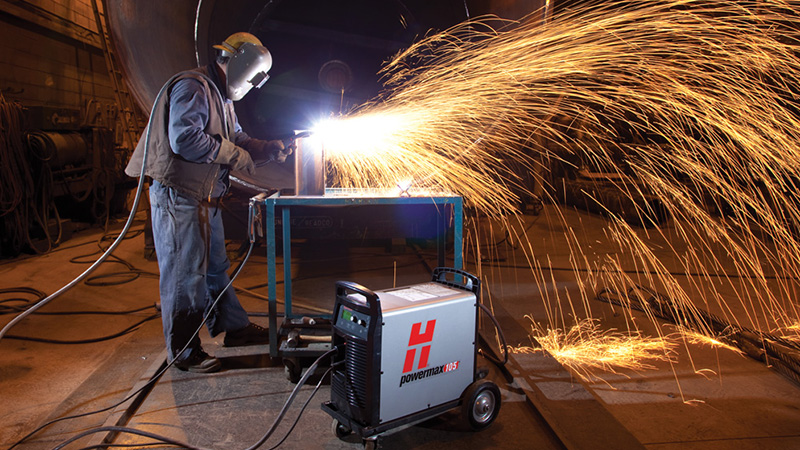The most important recommendation for the use of plasma cutting equipment is to double check the compressor capacity. These are equipment that cut with compressed air, and the compressor is an essential part of the process.
The capacity of the compressor
One of the recommendations about the compressor, whether in manual or mechanized cutting, is that at least this compressor has a capacity of 200 liters and a motor of at least 3 to 4 horsepower.
This allows the air to maintain about 120 PSI at its output. The idea is that the compressor maintains a minimum pressure of 90 PSI and a maximum of 120 PSI.
If at any time the compressor drops to 75 PSI, the cut may be compromised.
The importance of properly selecting the compressor to use can be seen in the following example: If you are in a mechanized plasma cutting equipment, cutting a whole sheet of 2.40 x 1.20 meters (which is a long cut), when about ten minutes have passed, the pressure could go down and the cut could be interrupted in any part of the process.
When the cut is interrupted, the precision of the pieces is lost, or some pieces of the sheet can be lost. That means a loss of material, time and manpower.
That is why it is always important to select a compressor that has sufficient capacity and strength.
The hose
Another issue to consider is the compressor hose. The basic recommendation for both manual plasma cutting and machining, where there is not much distance from the compressor to the cutting area, is to maintain at least 90 PSI of pressure.
Now, if the length from where the compressor is to the plasma cutting machine, or the cutting site itself is very long, it is recommended that the diameter of the hose be greater.
For example, if you are at a distance of less than 3 meters, a hose of at least 3/8″ is recommended. This provides sufficient flow so that there is no pressure loss in the distance from the compressor to the cut. If the distance is greater than 3 meters it is recommended to pass to a hose of 1/2″.
However, no matter how thick the hose may be, if the distance is too long, maybe 10 to 15 meters, it is normal a pressure drop due the length.
This could be corrected by placing the minimum compressor pressure from 90 to 95 PSI, or simply maintaining a constant pressure between 100 to 120 PSI, as the case may be.
Apart from the hoses it is also recommended to purge the compressor first thing in the morning, since the compressor stores water that is in the environment, it condenses inside the compressor and that water is harmful to the plasma cutting process.
We know that water and electricity do not get along and if that water goes through the cutting process or the tip of the torch, the consumables, the torch, will be used much more quickly and will limit the life of the equipment, without that is related to the guarantee.
About the consumables
The condition of consumables must also be taken into account. It must be verified that there is no humidity and that there are no deposits of grease.
This grease could come from several machine tools that you could have in the same metal pipe.
In some companies there are pneumatic networks, where there are several pneumatic machines connected to the same source, such as a giant compressor that feeds the entire network.
When you have a pneumatic network of this type, not only the condensation of the water can affect, but also part of the grease coming from the machines can move and enter the plasma cutting equipment.
A compressor alone for the exclusive use of plasma cutting is it an important recommendation to avoid the problem of grease in the pipe.
It is always recommended to keep consumables in good condition. Always the electrode and the nozzle should be changed at the same time to ensure the quality of the cut.





